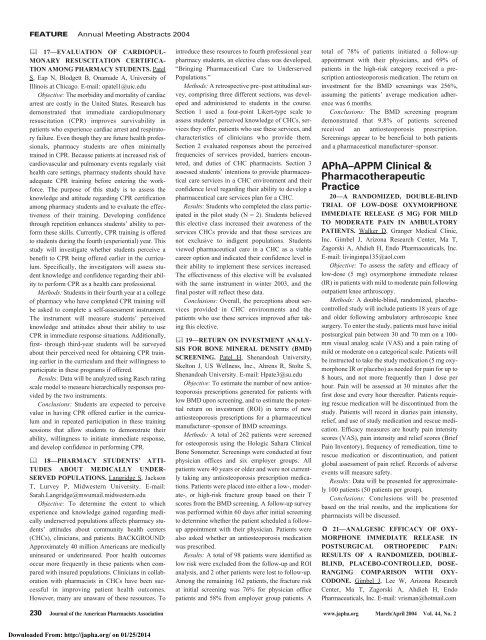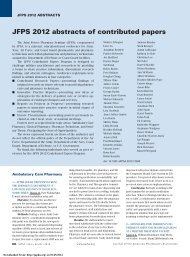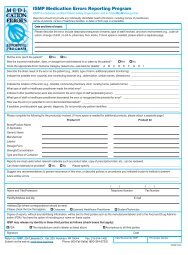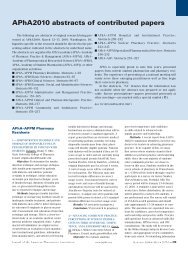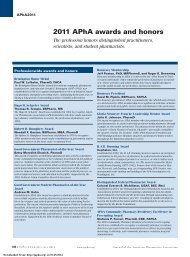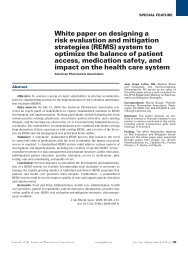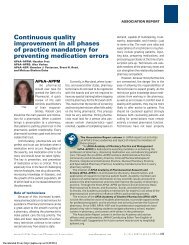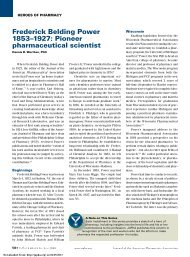Downloaded - Journal of American Pharmacists Association
Downloaded - Journal of American Pharmacists Association
Downloaded - Journal of American Pharmacists Association
You also want an ePaper? Increase the reach of your titles
YUMPU automatically turns print PDFs into web optimized ePapers that Google loves.
FEATURE Annual Meeting Abstracts 2004<br />
17—EVALUATION OF CARDIOPUL-<br />
MONARY RESUSCITATION CERTIFICA-<br />
TION AMONG PHARMACY STUDENTS. Patel<br />
S, Eap N, Blodgett B, Onamade A, University <strong>of</strong><br />
Illinois at Chicago. E-mail: opatel1@uic.edu<br />
Objective: The morbidity and mortality <strong>of</strong> cardiac<br />
arrest are costly in the United States. Research has<br />
demonstrated that immediate cardiopulmonary<br />
resuscitation (CPR) improves survivability in<br />
patients who experience cardiac arrest and respiratory<br />
failure. Even though they are future health pr<strong>of</strong>essionals,<br />
pharmacy students are <strong>of</strong>ten minimally<br />
trained in CPR. Because patients at increased risk <strong>of</strong><br />
cardiovascular and pulmonary events regularly visit<br />
health care settings, pharmacy students should have<br />
adequate CPR training before entering the workforce.<br />
The purpose <strong>of</strong> this study is to assess the<br />
knowledge and attitude regarding CPR certification<br />
among pharmacy students and to evaluate the effectiveness<br />
<strong>of</strong> their training. Developing confidence<br />
through repetition enhances students’ ability to perform<br />
these skills. Currently, CPR training is <strong>of</strong>fered<br />
to students during the fourth (experiential) year. This<br />
study will investigate whether students perceive a<br />
benefit to CPR being <strong>of</strong>fered earlier in the curriculum.<br />
Specifically, the investigators will assess student<br />
knowledge and confidence regarding their ability<br />
to perform CPR as a health care pr<strong>of</strong>essional.<br />
Methods: Students in their fourth year at a college<br />
<strong>of</strong> pharmacy who have completed CPR training will<br />
be asked to complete a self-assessment instrument.<br />
The instrument will measure students’ perceived<br />
knowledge and attitudes about their ability to use<br />
CPR in immediate response situations. Additionally,<br />
first- through third-year students will be surveyed<br />
about their perceived need for obtaining CPR training<br />
earlier in the curriculum and their willingness to<br />
participate in these programs if <strong>of</strong>fered.<br />
Results: Data will be analyzed using Rasch rating<br />
scale model to measure hierarchically responses provided<br />
by the two instruments.<br />
Conclusions: Students are expected to perceive<br />
value in having CPR <strong>of</strong>fered earlier in the curriculum<br />
and in repeated participation in these training<br />
sessions that allow students to demonstrate their<br />
ability, willingness to initiate immediate response,<br />
and develop confidence in performing CPR.<br />
18—PHARMACY STUDENTS’ ATTI-<br />
TUDES ABOUT MEDICALLY UNDER-<br />
SERVED POPULATIONS. Langridge S, Jackson<br />
T, Lurvey P, Midwestern University. E-mail:<br />
Sarah.Langridge@mwumail.midwestern.edu<br />
Objective: To determine the extent to which<br />
experience and knowledge gained regarding medically<br />
underserved populations affects pharmacy students’<br />
attitudes about community health centers<br />
(CHCs), clinicians, and patients. BACKGROUND:<br />
Approximately 40 million <strong>American</strong>s are medically<br />
uninsured or underinsured. Poor health outcomes<br />
occur more frequently in these patients when compared<br />
with insured populations. Clinicians in collaboration<br />
with pharmacists in CHCs have been successful<br />
in improving patient health outcomes.<br />
However, many are unaware <strong>of</strong> these resources. To<br />
introduce these resources to fourth pr<strong>of</strong>essional year<br />
pharmacy students, an elective class was developed,<br />
“Bringing Pharmaceutical Care to Underserved<br />
Populations.”<br />
Methods: A retrospective pre–post attitudinal survey,<br />
comprising three different sections, was developed<br />
and administered to students in the course.<br />
Section 1 used a four-point Likert-type scale to<br />
assess students’ perceived knowledge <strong>of</strong> CHCs, services<br />
they <strong>of</strong>fer, patients who use these services, and<br />
characteristics <strong>of</strong> clinicians who provide them.<br />
Section 2 evaluated responses about the perceived<br />
frequencies <strong>of</strong> services provided, barriers encountered,<br />
and duties <strong>of</strong> CHC pharmacists. Section 3<br />
assessed students’ intentions to provide pharmaceutical<br />
care services in a CHC environment and their<br />
confidence level regarding their ability to develop a<br />
pharmaceutical care services plan for a CHC.<br />
Results: Students who completed the class participated<br />
in the pilot study (N = 2). Students believed<br />
this elective class increased their awareness <strong>of</strong> the<br />
services CHCs provide and that these services are<br />
not exclusive to indigent populations. Students<br />
viewed pharmaceutical care in a CHC as a viable<br />
career option and indicated their confidence level in<br />
their ability to implement these services increased.<br />
The effectiveness <strong>of</strong> this elective will be evaluated<br />
with the same instrument in winter 2003, and the<br />
final poster will reflect these data.<br />
Conclusions: Overall, the perceptions about services<br />
provided in CHC environments and the<br />
patients who use these services improved after taking<br />
this elective.<br />
19—RETURN ON INVESTMENT ANALY-<br />
SIS FOR BONE MINERAL DENSITY (BMD)<br />
SCREENING. Patel H, Shenandoah University,<br />
Skelton J, US Wellness, Inc., Ahrens R, Stolte S,<br />
Shenandoah University. E-mail: Hpate3@su.edu<br />
Objective: To estimate the number <strong>of</strong> new antiosteoporosis<br />
prescriptions generated for patients with<br />
low BMD upon screening, and to estimate the potential<br />
return on investment (ROI) in terms <strong>of</strong> new<br />
antiosteoporosis prescriptions for a pharmaceutical<br />
manufacturer–sponsor <strong>of</strong> BMD screenings.<br />
Methods: A total <strong>of</strong> 262 patients were screened<br />
for osteoporosis using the Hologic Sahara Clinical<br />
Bone Sonometer. Screenings were conducted at four<br />
physician <strong>of</strong>fices and six employer groups. All<br />
patients were 40 years or older and were not currently<br />
taking any antiosteoporosis prescription medications.<br />
Patients were placed into either a low-, moderate-,<br />
or high-risk fracture group based on their T<br />
scores from the BMD screening. A follow-up survey<br />
was performed within 60 days after initial screening<br />
to determine whether the patient scheduled a followup<br />
appointment with their physician. Patients were<br />
also asked whether an antiosteoporosis medication<br />
was prescribed.<br />
Results: A total <strong>of</strong> 98 patients were identified as<br />
low risk were excluded from the follow-up and ROI<br />
analysis, and 2 other patients were lost to follow-up.<br />
Among the remaining 162 patients, the fracture risk<br />
at initial screening was 76% for physician <strong>of</strong>fice<br />
patients and 58% from employer group patients. A<br />
total <strong>of</strong> 78% <strong>of</strong> patients initiated a follow-up<br />
appointment with their physicians, and 69% <strong>of</strong><br />
patients in the high-risk category received a prescription<br />
antiosteoporosis medication. The return on<br />
investment for the BMD screenings was 256%,<br />
assuming the patients’ average medication adherence<br />
was 6 months.<br />
Conclusions: The BMD screening program<br />
demonstrated that 9.8% <strong>of</strong> patients screened<br />
received an antiosteoporosis prescription.<br />
Screenings appear to be beneficial to both patients<br />
and a pharmaceutical manufacturer–sponsor.<br />
APhA–APPM Clinical &<br />
Pharmacotherapeutic<br />
Practice<br />
20—A RANDOMIZED, DOUBLE-BLIND<br />
TRIAL OF LOW-DOSE OXYMORPHONE<br />
IMMEDIATE RELEASE (5 MG) FOR MILD<br />
TO MODERATE PAIN IN AMBULATORY<br />
PATIENTS. Walker D, Granger Medical Clinic,<br />
Inc. Gimbel J, Arizona Research Center, Ma T,<br />
Zagorski A, Ahdieh H, Endo Pharmaceuticals, Inc.<br />
E-mail: livinginpa135@aol.com<br />
Objective: To assess the safety and efficacy <strong>of</strong><br />
low-dose (5 mg) oxymorphone immediate release<br />
(IR) in patients with mild to moderate pain following<br />
outpatient knee arthroscopy.<br />
Methods: A double-blind, randomized, placebocontrolled<br />
study will include patients 18 years <strong>of</strong> age<br />
and older following ambulatory arthroscopic knee<br />
surgery. To enter the study, patients must have initial<br />
postsurgical pain between 30 and 70 mm on a 100-<br />
mm visual analog scale (VAS) and a pain rating <strong>of</strong><br />
mild or moderate on a categorical scale. Patients will<br />
be instructed to take the study medication (5 mg oxymorphone<br />
IR or placebo) as needed for pain for up to<br />
8 hours, and not more frequently than 1 dose per<br />
hour. Pain will be assessed at 30 minutes after the<br />
first dose and every hour thereafter. Patients requiring<br />
rescue medication will be discontinued from the<br />
study. Patients will record in diaries pain intensity,<br />
relief, and use <strong>of</strong> study medication and rescue medication.<br />
Efficacy measures are hourly pain intensity<br />
scores (VAS), pain intensity and relief scores (Brief<br />
Pain Inventory), frequency <strong>of</strong> remedication, time to<br />
rescue medication or discontinuation, and patient<br />
global assessment <strong>of</strong> pain relief. Records <strong>of</strong> adverse<br />
events will measure safety.<br />
Results: Data will be presented for approximately<br />
100 patients (50 patients per group).<br />
Conclusions: Conclusions will be presented<br />
based on the trial results, and the implications for<br />
pharmacists will be discussed.<br />
21—ANALGESIC EFFICACY OF OXY-<br />
MORPHONE IMMEDIATE RELEASE IN<br />
POSTSURGICAL ORTHOPEDIC PAIN:<br />
RESULTS OF A RANDOMIZED, DOUBLE-<br />
BLIND, PLACEBO-CONTROLLED, DOSE-<br />
RANGING COMPARISON WITH OXY-<br />
CODONE. Gimbel J, Lee W, Arizona Research<br />
Center, Ma T, Zagorski A, Ahdieh H, Endo<br />
Pharmaceuticals, Inc. E-mail: vrisman@hotmail.com<br />
230 <strong>Journal</strong> <strong>of</strong> the <strong>American</strong> <strong>Pharmacists</strong> <strong>Association</strong> www.japha.org March/April 2004 Vol. 44, No. 2<br />
<strong>Downloaded</strong> From: http://japha.org/ on 01/25/2014


